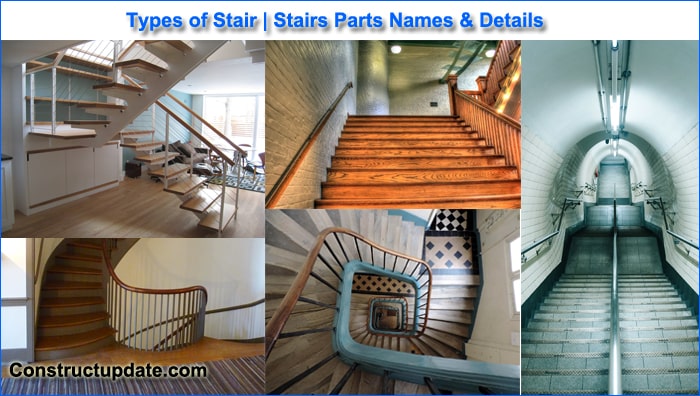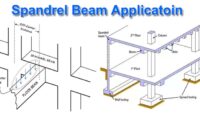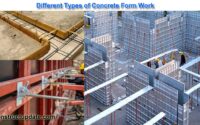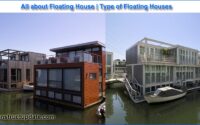What is Staircase | Types of Staircase | Parts of Staircase
A staircase is a structure that allows us to move from one floor to another. It is a critical component of any building. The size of the steps varies depending on the type of building.
Types of Staircase
- Wood, concrete masonry, or cast iron may be used to construct the stairwell.
- Because of the risk of fire, wooden steps are not recommended.
- However, they are utilised to get access to minor rooms on the upper floors of inconsequential structures.
- To reduce the staircase size, cast iron or steel staircases in spiral forms were commonly used.
- Masonry staircases are also employed in many residential constructions.

Following are the types of various kind of Stairs:
- Straight Stairs
- Dog Legged Stairs
- Well or Open-Newel Stairs
- Geometrical Stairs
- Spiral Stairs
- Bifurcated stairs
- Turning Stairs
- Circular Stair
Straight Stairs
Straight steps may be used if the area available for the staircase is lengthy and narrow.
These steps are commonly utilised to provide access to a porch or as emergency exits from movie theatres.
All of the steps are in the same direction. They can be delivered in a single flight or two flights with a landing in between.
Dog Legged Stairs
It consists of two straight flights separated by a 180° turn. They are used very gently to provide passage from one floor to the next. This arrangement of steps in such stairs is shown in the diagram below.
Well Newel Stairs
Open-Newel Stairs are another name for Newel Stairs.
It varies from dog-legged stairs in that the intervals between the two adjacent flights are 0.15 m to 1.0 m in this case.
Geometrical Stair
This stair is similar to an open newel stair with the exception that the well-formed between the two neighbouring steps are curved. There is a continuous railing supplied.
Spira Stairs
- Typically, these staircases are used as emergency exits. It is made up of a centre post that is supported by a spiralling succession of stairs.
- At the end of the steps, a continuous handrail is provided.
- A continuous handrail is installed at the top of the steps.
- Where there isn’t enough space for stairs, such as where there isn’t enough space for stairs.
Bifurcated stairs
- Stairs can turn in a variety of ways, including open newels and dog-legged turns.
- They are dependent on the amount of stair space available. Bifurcated stairs, quarter-turned half-turned with few steps in between, and quarter-turned half-turned with few steps in between are examples of twisted stairs.
A staircase has several components or pieces, each with its own function. Staircases come in a variety of shapes and configurations to suit certain qualities, but the essential components that go up to make any staircase are rather common.
Following are the various components of a staircase:
- Step
- Nosing
- Bullnose
- String
- Winders
- Balustrade
- Handrail
- Newel
- Volute
- Baluster
- Turnout
- Gooseneck
- Rosette
- Easing
- Trim
- Finial
- Fillet
- Flutes
Step: A step is composed of tread and riser.
Tread
Tread is a stepped-in fragment of the stairwell. It is the top or horizontal surface that the feet press upon. It is walked on when ascending or descending the stairwell. It has the same thickness as other types of flooring. In a staircase, there is always one tread less than risers. The number of threads combined together will equal the overall horizontal distance of the steps.
Riser
The riser is the vertical section of the stair that runs between each tread. Risers aren’t required on all stairwells. The open thread is a set of steps with no elevation. In recent years, open riser stairs have become increasingly fashionable. Risers are included in the closed tread stair. The vertical board serves as the step’s face as well as the gap between each step.
Nosing: The horizontal, projecting edge of a stair where the majority of foot activity occurs is known as the nosing. The half-rounded moulding that conceals where the balusters fit into the treads is usually fastened to the ends of the threads exposed in a half. The edge of the tread that extends beyond the face of the riser and the face of a cut string is known as nosing. When the thread above a riser overhangs it, this is called overhanging. In some situations, the tread may be devoid of a nosing.
Bullnose: It’s referred to as the first footstep. When one or both sides of the stairs are unbolted, the first step above the lower floor may be wilder and rounder than the subsequent steps. A staircase with a double bullnose is one that is not against a wall and has a bullnose on both ends of the first step.
String: Stringer or stringer board are other names for it. The structural supports run down both sides of the stairwell, although the treads can be supported in a variety of ways. The risers and treads are occasionally notched to fit into the stringers.
Winders: The stairs that are thinner on one side than the other are known as winders. A spiral or circular stairway is formed by a series of winders. Triangular treads are used to finish stairway winders or turns. The middle step is known as a kite winder or a kite double winder when three steps are utilised to turn a 90-degree corner. According to the Toronto Home Inspection, a staircase should only have one set of winders and the measurements should be tripping risks.
Balustrade: The full assembly of handrails, base-rails, newels, spindles, infill, and newer caps is referred to as a balustrade.
Handrail: The phrase “handrail” is sometimes used to refer to only the bannister, and other times it refers only to the balusters. A handrail is a rail that is designed to be grabbed by the hand in order to offer support or stability. It’s also referred to as a railing or a bannister. They’re usually supported by posts or attached to the wall directly. On a big staircase, there may be a railing on both sides, sometimes just on one side, or none at all; on a narrow staircase, there may be one in the middle, or even more. Handrails that go up the side or sides of a stairwell, as well as along the edge of a landing.
Newel: A robust vertical post at the end or turn of a bannister is known as a newel. A central pole or support column is sometimes known as a newel. It extends below the floor and subfloor to the bottom of the floor joists and is bolted directly to the floor joist because it is a structural component. Standard, landing, pin-top, and stabiliser newel posts are the four types of newel stair posts. Half of the newel appears to be imbedded in the wall. A decorative newel drop can be added to open landings by extending a newel below the landing.
Volute: A volute is a spiral-shaped railing termination component for curtail or bullnose steps that bend inward. Depending on which side of the railing one looks up the stairs, it is considered to be left or right-handed. The detail resembles a scroll at the handrail’s entry, sometimes known as a monkey’s tail. It is installed at the bottom of a starting step, stretching out from the side of the staircase, and comes with an up-ramp. It does, however, have the most complicated installation process of any staircase.
Baluster: The term “baluster” refers to the structure that supports the railing. It’s a vertical element that connects the treads or floor to the space beneath the bannister ( on the side of a landing). It’s also known as the guard or the spindle.
Turnout: A turnout is a quarter-turn rounded termination to the railing, rather than a complete spiral volute. It’s a fashionable way to begin a stairwell. They’re not as dramatic as volutes, but they’re nonetheless appealing. There are two forms of turnout: left and right-hand turnout. A right turnout is on the right side of the stairs if you’re facing the bottom, and a left turnout is on the left side if you’re facing the bottom. A newel post with a pin top must be installed beneath a turnout.
Gooseneck: A gooseneck is a vertical handrail that connects a slanted handrail on the balcony or landing to a higher railing. It’s a piece of the stair handrail. Vertical turn + up-ramp Equals Gooseneck. Goosenecks are available in a wide range of shapes and sizes. Avoid buying a gooseneck that isn’t compatible with your handrail.
Rosette: A rosette can be used to trim the handrail where it meets the wall when a half-newel is not required. It’s a decorative wood stair section that’s available as an option. While they are more of a decorative feature, they do make the procedure of connecting a handrail to a wall easier. If your balustrade is in the traditional design, rosettes will offer an extra touch of elegance. If you like a cleaner, more contemporary look, you should probably skip the rosette.
Easing: Any form of hand railing direction shift is referred to as easing. Wall brackets are used to mount wall railings directly to the wall. Such railings flare to a horizontal railing at the bottom of the stairs, and the horizontal portion is referred to as a starting rising. The horizontal piece of the railing at the top of the steps is known as – over easing. Up easing is a railing feature that allows you to change the handrail’s direction from angular to vertical.
Trim: Trim is typically utilised where walls touch the ground, and I frequently use it where the tread and riser meet. Between the lower level and the first riser, shoe moulding can be employed. Because the last riser above the lower floor is rounded, trimming a starting step presents a unique issue.
Finial: A final is a decorative cap that goes on top of a newel post, usually at the end of a railing.
Fillet: The fillet is a decorative filler that is placed between the balusters of a balcony railing on the floor.
Flutes: Flutes are beautiful vertical grooves carved onto the wood surface of newel posts’ spindles.




